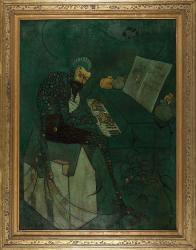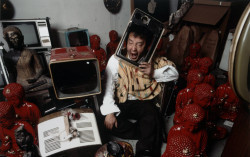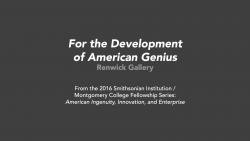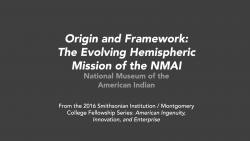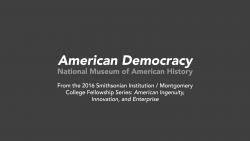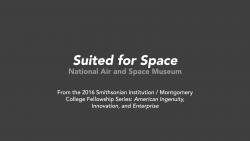Tess Porter
User Experience Strategist (she/her)
Smithsonian Office of Educational Technology
I'm the former User Experience Strategist at the Smithsonian Office of Educational Technology. Here, I focused on the use of digital museum resources to support teaching and learning. My work draws on my experience as a museum educator, digital analyst, usability researcher, and content designer. I hold a B.A. in Anthropology and a B.A. in Art History from University Colorado Boulder, and an M.S. in Museums and Digital Culture with an Advanced Certificate in User Experience from Pratt Institute.
Tess Porter's collections
Dissolution of Native American Territory 1885-1905
<p>This student activity examines what events, including the Dawes Act of 1887, contributed to the change in Native American reservation boundaries over time. Includes a video discussing 19th century views toward Native Americans, maps of reservation territory in 1885, 1895, 1905, and 1965, discussion questions, and an opportunity to learn more using an interactive map.</p>
<p>Big idea: Understand how boundaries of Native American reservations have changed over time, and what events lead to the alteration of borders.</p>
<p>Keywords: American Indian, western expansion</p>
 Tess Porter
Tess Porter
8
Designing a Better Voting Machine: 1880s to Today
<p>Objects are time capsules; they embody values, aspirations, or problems of a particular time and place and mark a stage of technological evolution. This student activity examines voting machines used in U.S. elections over more than a century. Looking closely and understanding the historical objects’ design evolution will inform students’ design of new machine intended to overcome barriers to voting in today's elections. </p>
<p>The first five images are voting machines from the late 1800s to the early 2000s. Students will explore their parts, purposes, and complexities, then read the Washington Post article "Broken machines, rejected ballots and long lines: voting problems emerge as Americans go to the polls." Finally, students will design (and may prototype) a voting machine.<br /></p>
<p>This collection incorporates two Project Zero Agency by Design routines: <em></em><a href="https://learninglab.si.edu/collections/agency-by-design-voting/xf6JuBhCB1u29e8h/#r/517111">Parts, Purposes, Complexities</a>, a routine for looking closely; and <a href="https://learninglab.si.edu/collections/agency-by-design-voting/xf6JuBhCB1u29e8h/#r/517112">Imagine If...</a>, a routine for finding opportunity. Questions in each routine are open-ended and should be used to spark peer discussion in small groups or as a class. For more information on how to use and facilitate each routine, see their resource tiles at the end of the collection, as well as the <a href="http://www.agencybydesign.org/">Agency by Design website</a>.</p>
<p><em>Keywords: vote, voter, maker, making </em></p>
 Tess Porter
Tess Porter
13
Compare and Contrast: Personal Perspectives in Portraiture
<p>In this activity, students will explore how portraits reflect both the personality of the subject and the artist's personal view of the subject. They will examine two portraits - both painted by James McNeill Whistler of his patron (and eventually ex-patron) Frederick Richards Leyland. Using looking strategies, students will compare and contrast the artist's perspective of his subject before connecting the portraits to music as a final activity.</p><p>Big Idea: How do portraits reflect both the personality of the subject and the artist’s view of their subject? How can visual art and music communicate similar messages?</p>
<p>This collection was created for the District of Columbia Public Schools (DCPS) Arts Professional Development Day. It was created in collaboration with the <a href="https://learninglab.si.edu/profile/freersackler_education">Education Department at the Freer Gallery of Art and Arthur M. Sackler Gallery</a>.</p>
<p>Keywords: Peacock Room</p>
 Tess Porter
Tess Porter
6
Bracero Program: Step In, Step Out, Step Back
<p>In this activity, students will examine a painting of Mexican guest-workers, known as braceros, involved in the Bracero Program (1942-1964), the largest guest-worker program in US history. Started as a temporary war measure to address labor demands in agriculture and railroads, the program allowed Mexican nationals to take temporary agricultural work in Texas, New Mexico, Arizona, California, and 24 other states. By the time the program ended in 1964, over 4.6 million work contracts were awarded.
</p>
<p>Using a Project Zero Global Thinking Routine - "Step In - Step Out - Step Back" - students will examine the perspectives of those depicted in the painting, consider what it means to take the perspectives of others, and explore avenues and methods to learn more about Braceros. Resources for learning more about the Bracero program are located at the end of the collection and include: <em>Bittersweet Harvest</em>, a digital exhibition about the Bracero Program; the <em>Bracero History Archive</em>, which includes oral histories, objects, and more; and a Learning Lab collection of photographs documenting the Bracero Program.</p>
<p>Keywords: laborer, immigration, work, migration, migrant workers, agriculture, reform, politics, government, photojournalism, activity, inquiry strategy, global competency, global competence, latino, chicano, 1940s, 40s, 1950s, 50s, 1960s, 60s</p><p>#EthnicStudies</p>
 Tess Porter
Tess Porter
6
Bob Dylan and Woody Guthrie: Teaching Resources
<p>This topical collection gathers resources about Bob Dylan, one of the most influential American music artists of the 20th century, and Woody Guthrie, who greatly influenced the work of Dylan and other folk artists. Ideas for classroom application located in "Notes to Other Users." Resources include images, videos, music, and a lesson plan.</p>
<p>Tags: minnesota; hibbing; folk music; medieval music; ballad; #SmithsonianMusic<br /></p>
 Tess Porter
Tess Porter
15
Bessie Smith: Examining Portraiture
<p>This teacher's guide provides portraits and analysis questions to enrich students' examination of Bessie Smith, the "Empress of the Blues" and one of the most influential blues singers in history. Includes the video "Defining Portraiture: How are portraits both fact and fiction?" and the National Portrait Gallery's "<em>Reading" Portraiture Guide for Educators, </em>both of which provide suggestions and questions for analyzing portraiture. Also includes a video clip of Bessie Smith performing "St. Louis Blues" in 1929 and a post from the National Museum of African American History and Culture discussing her and other LGBTQ African Americans of the Harlem Renaissance.</p>
<p>Consider:</p>
<ul><li>What do these portraits have in common? How are they different?</li><li>How are these portraits both fact and fiction?</li><li>How do these portraits reflect how she wanted to be seen, or how others wanted her to be seen? Consider for what purpose these portraits were created.</li><li>Having listened her music, does the portrait capture your image of Bessie Smith? Why, or why not?</li><li>If you were creating your own portrait of Bessie Smith, what characteristics would you emphasize, and why?</li></ul><p>Keywords: singer, musician, 20s, 30s, American, Tennessee, #BecauseOfHerStory, #SmithsonianMusic</p>
 Tess Porter
Tess Porter
11
Ancient Greek Myth: Reinterpreted by African American Artists
<p>In this student activity, analyze the timelessness of myth through three works of art by modern African American artists. Each artist, inspired by Ancient Greek myth, retells stories and reinterprets symbols to explore personal and universal themes. Includes three works of art, summaries of the myths they reference, and discussion questions. Also includes a video about the artist Romare Bearden and his series 'Black Odyssey,' which details Bearden's artistic process, the significance of storytelling in his art, and the lasting importance of 'Black Odyssey.'</p>
<p>Big Ideas: How does myth reflect the values of an individual or their culture? How do myths reflect the human experience? How do myths transcend time and place?</p>
<p>Inspired by a Smithsonian American Art Museum lesson plan, located <a href="https://americanart.si.edu/education/k-12/resources/african-american">here</a>.</p>
<p>Keywords: greece, alma thomas, bob thompson</p>
 Tess Porter
Tess Porter
6
Ancient Egyptian Stelae: See Think Wonder
<p>Using the Project Zero Visible Thinking routine "See Think Wonder," this activity explores multiple stelae, or funerary markers, from Ancient Egypt. Through analysis of these stelae, students will gain an understanding of: the different functions of stelae, their common characteristics, and how they fit into the larger picture of Ancient Egyptian funerary practice and afterlife beliefs.</p>
<p>Keywords: stela, stele, steles, stelai, memorial, commemorative, inquiry strategy, archaeology</p>
<p><em>#historicalthinking</em></p>
 Tess Porter
Tess Porter
5
Ancient Egyptian Religion & Social Hierarchy: Pyramids
<p>This student activity examines the importance of religion and social hierarchy in Ancient Egypt through the construction of pyramids. Details evolution over time and encourages cross-cultural comparison. Includes photographs, an artifact, a video, a reading-level appropriate article, and opportunities to learn more at the Met Museum website and Google Street View.</p><p>Big Questions: </p><p></p><ul><li>How did the pyramids evolve over time? </li><li>How does this evolution reflect the importance of religion and social hierarchy in Ancient Egyptian urban society?</li></ul><p></p><p>Keywords: archaeology</p>
 Tess Porter
Tess Porter
12
American Ingenuity, Innovation, and Enterprise: National Museum of American Indian Seminar Resources
<p>This collection previews the second seminar of the 2016 Montgomery College / Smithsonian Institution Fellowship seminar series. Fellows will visit the National Museum of the American Indian, tour the exhibition "The Great Inka Road: Engineering an Empire," and watch the documentary "Caravan of Memory." Dr. José Barreiro, Assistant Director for Research, Director of the Office for Latin America, and co-curator of "The Great Inka Road," will lead the seminar.</p>
<p>Included in this collection: bio of presenter, presentation description, and resources chosen by the presenter for attendees to explore before attending the session. These resources are not required, but will help fellows prepare for discussion the day of the seminar.</p><p>#MCteach<br /></p>
 Tess Porter
Tess Porter
6
American Ingenuity, Innovation, and Enterprise: National Museum of American History Seminar Resources
<p>This collection previews the fifth and final seminar of the 2016 Montgomery College / Smithsonian Institution Fellowship seminar series. Fellows will visit the National Museum of American History to explore the issues and topics surrounding the upcoming exhibition, "American Democracy: A Great Leap of Faith." Harry Rubenstein, Curator and Chair of the Division of Political History, will lead the seminar.</p>
<p>Included in this collection: bio of presenter, presentation description, and resources for attendees to explore before attending the session. The first two resources in this collection - the video "Bill Geist with curators Harry Rubenstein and Larry Bird on the campaign trail, 1996" and image "Where is Democracy" with attached quiz question - are required. The others are not, but will help fellows prepare for discussion the day of the seminar.</p><p>#MCteach<br /></p>
 Tess Porter
Tess Porter
7
American Ingenuity, Innovation, and Enterprise: National Air and Space Museum Seminar Resources
<p>This collection previews the fourth seminar of the 2016 Montgomery College / Smithsonian Institution Fellowship seminar series. Fellows will visit the National Air and Space Museum to learn about the design and development of space suits, as well as current conservation challenges and strategies. Two National Air and Space Museum staff members will lead this seminar: Cathy Lewis, Curator of International Space Programs and Spacesuits, and Lisa Young, Objects Conservator.</p>
<p>Included in this collection: presenter bios, presentation description, and resources for attendees to explore before attending the session. The first resource in the collection - "A Picture is Worth a Thousand Words: Using X-radiographs of the National Air and Space Museum's Spacesuit Collection to Promote Preservation" - is required. The other resources are not required, but will help prepare for discussion the day of the seminar.</p><p>#MCteach<br /></p>
 Tess Porter
Tess Porter
17


